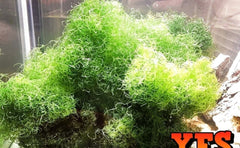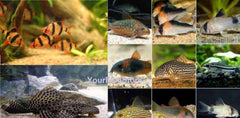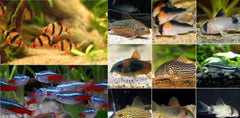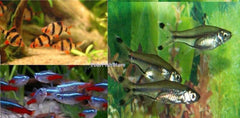Copper Band Butterfly Fish - Medium 2" - 3" Each Free Shipping

COPPER BAND BUTTERFLY FISH - MEDIUM 2" - 3" EACH FREE SHIPPING
Minimum Tank Size: 100 gallons
Care Level: Moderate
Temperament: Peaceful
Reef Compatible: With Caution
Water Conditions: 72-78° F, dKH 8-12, pH 8.1-8.4, sg 1.020-1.025
Max. Size: 8"
Natural Environment:
Comes from reefs in the Pacific and Indian Oceans in waters 1-25 meter in depth. They are typically found singly or in pairs and are territorial thus staying in one area of the reef.
Reef Tank Suitability:
The Copperband is a very attractive fish and ‘can’ be a great addition to a reef tank. Butterflyfish in general are viewed as potential coral eaters, but the Copperband Butterflyfish are generally reef safe though there can be quite a lot of variability between individual fish as to what they consider food in the tank. In all cases, they will deplete the tank of any small fan worms or other small worms. Some may nip at coral, but typically not to the extent of being a major concern in a larger tank.
Copperbands benefit from good water quality which reef tanks typically provide.
They are sometimes used in the control of the pest Aiptasia anemone. This is a hit or miss affair as some specimens will eat them and some do not. I know of LFS that cycle Copperbands around their various tanks to control Aiptasia with good success. I personally have never seen any of my Copperbands eat Aiptasia. A visitor to ReefCorner has reported success with teaching his Copperband to eat Aiptasia by putting chunks of food he liked to eat into the Aiptasia. As the Copperband went for the food it would also get a taste of the Aiptasia. Eventually it learned to eat them without this prompt. Seems like a good thing to try if you find yourself in a similar position. It has also been reported that Yellow Polyps that have the same basic body shape and size as Aiptasia have also been the target of Copperbands.
Disposition:
Copperbands are a very non-aggressive fish. It can be bullied by more aggressive fish in the tank, so be on the lookout for this when introducing a new fish. They are aggressive to their own species, so only one should be kept in a tank to prevent fighting unless the tank is very large or you know that they are a mated pair.
Feeding:
The Copperband will get part of its nutrition from feeding on the small life forms found on live rock. It is especially fond of small fan worms or small worms of any type. They will also usually take smallish meaty foods such as frozen brine shrimp or blood worms and sometimes Mysis shrimp. Keep in mind that they have very small mouths and will usually not attempt to eat the larger foods that are offered. Getting them to feed on a nutritionally balanced diet is often the most difficult part of being successful with this fish. Stubborn fish may accept live foods or pick at opened clams. Black worms might be a good option to try to entice a reticent eater though I haven’t had the opportunity to try them with a Copperband. Copperband butterflyfish may compete for food with other live rock foragers such as Mandarin Dragonets that are in the tank.
Hardiness:
The Copperband can be a somewhat delicate fish, but once successfully acclimated they seem to be fairly hardy. Good nutrition is key to their long-term success. They are not a good starter fish and should not be kept by inexperienced aquarists.
Temperature:
Does well within normal reef tank temperature ranges of approximately 75-84°F.
Size:
Copperbands can get up to about 8″ in length in the wilds but are typically about 4″ in captivity. Since they are fairly shy fish and may not compete for food well and which can benefit from being able to browse for some of their food on live rock, they will do best in larger tanks of 70 gallons or larger with large amounts of live rock.
Breeding:
Copperband Butterflyfish are not breed in captivity at this time.
It is best housed in very large reefs, or in peaceful community tanks. It should be kept singly, not with conspecifics or similar butterflyfish, and should not be kept with any stress-inducing fish. Caution should be exercised if housing these fish in a reef aquarium. They may pick on invertebrates, especially anemones and feather dusters. They are an excellent fish when used to control aiptasia, or glass anemones, in the reef aquarium.
Customer Reviews
Based on 1 review
Write a review
QUESTIONS & ANSWERS
Have a Question?
Be the first to ask a question about this.














